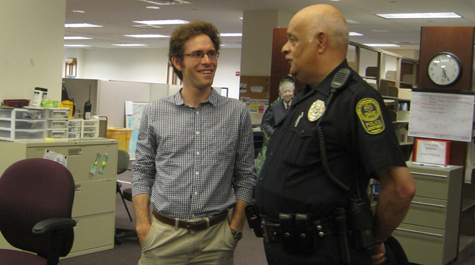Jim Barbour, W&M's Father Time, marches on
There’s no better example of the relationships Jim Barbour has forged with the William & Mary community over five decades in its police department than the time he was home recuperating from a broken collarbone.
At the time, he was working security at Swem Library. A letter came to him from a student and his girlfriend, who were frequently the last people to leave the library at night.
“‘Don’t worry,’” Barbour recalled the couple writing. “‘We’ll be glad when you’re back, but we’ll take care of the library while you’re gone. We’ll make sure everybody is out when the library closes.’”
Barbour, now a part-time W&M police officer, will be honored for 55 years of service to the university on June 12, one of more than 200 employees who will be recognized for reaching milestone service anniversaries of five years or more.
“If we had to use just a few terms to describe Officer Barbour, they would be integrity, credibility and dedication,” said Chief of Police Deb Cheesebro. “He has received numerous commendations for excellent work, along with an overwhelming number of thank-you messages from community members he has helped along the way.”
Maj. Don Butler added, “I’ve been in law enforcement for a long time, and Jim is the most senior police officer (and counting) that I’ve ever had the pleasure of serving with. He is incredibly loyal and dedicated to William & Mary students.
Barbour actually “retired” in 2000, a decision that lasted for all of two weeks. Then he returned to the force on a part-time basis, where now he covers special events and works shift patrols on a need basis. It keeps him plenty busy.
Barbour smiles at the thought that people no longer ask him the secret to serving for 55 years, but rather when he’s going to leave. They have a hard time believing he’s lasted as long as he has.
Cheesebro tells the story of a graduate who had been arrested on campus years ago but was seeking information that showed he had not been convicted of any felonies. Butler found the original arrest packet, saw that Barbour was the arresting officer, and they talked about the case.
When Butler told the man that he and Barbour had spoken, the man replied that that couldn’t be. The incident, he said, had occurred almost 40 years ago.
“The student and the major had a nice laugh, and we sent off the requested documentation,” Cheesebro said. “Major Butler let the student know that, if need be, the arresting officer from 1978 could vouch for their authenticity.”
Barbour spent more than four decades at Josiah Chowning’s Tavern in Colonial Williamsburg in addition to working at W&M. He was even offered a job there as an assistant manager several years ago. He turned it down because it would have meant quitting the force at William & Mary.
“I’m so glad I didn’t do that,” he said. “On campus, you get to meet people, get to talk to students, talk to tourists, talk to parents, the College community as a whole. I like to get out and talk to people. I think it keeps me young.”
Barbour, the first black officer hired at W&M, remembers a far different W&M than the one he patrols these days. For one, there were a lot of older retired military on staff back then, at least it seemed that way because he was so young, he said.
The campus was then divided into sectors that the officers walked for an hour or so before moving to another. Barbour said shifts consisted of seven hours of walking, during which time you’d see lots of people across a broad spectrum.
Walking the Sunken Garden and classrooms at night could be an “interesting” experience.
“Back in those days we didn’t have any lights around the Sunken Garden; it was completely dark,” he said. “And there weren’t many lights around the buildings. If they had any they were maybe 250 watts. You could be at one end of the Sunken Garden and not see the other. But after you stayed out there awhile, you could see figures walking across.”
The night he remembers most vividly occurred in January 1973. Christmas break had ended and students were returning to campus. Barbour’s shift had ended at midnight, and he was home in bed when the phone rang. Jefferson Hall was ablaze.
‘“We need you here in an hour,’” he remembered the fire lieutenant saying. “I told him that I was ready to go now. I got dressed and came in, and I worked from 5 a.m. to midnight the next night.”
Barbour’s influence within the department apparently knows no borders. He is a die-hard Chicago Cubs fan. Cheesebro has a deep allegiance to the Boston Red Sox. Because of Barbour, she now roots for both.
“Through 55 years, and still today,” Cheesebro said, “whenever the department and the community needs him, he is there for us.”
 Skip to main content
Skip to main content

